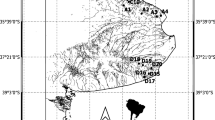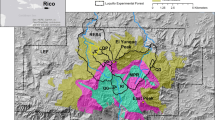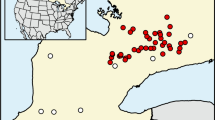Abstract
As increased greenhouse gas concentrations (GHG: N2O, CO2, CH4) in our atmosphere remain a major concern, better quantifying GHG fluxes from natural systems is essential. In this study, we investigate GHG concentrations in saturated riparian sediments (dry, wet, mucky), streambed hyporheic zone sediments (pools, riffles), and stream water in a New York mountain stream for summer baseflow conditions, and attempt to identify the primary drivers (e.g., DO, DOC, NO3 −, and NH4 +, temp) of GHG concentrations at these locations. Although DO, DOC, NO3 −, and NH4 + concentration patterns certainly explained some of the observed trends, the overall differences in GHG abundance in riparian water vs. hyporheic pool water vs. hyporheic riffle water strongly suggest that water velocity/mixing with the atmosphere is a key control on GHG concentration across locations. When all floodplain locations are considered, in-stream pools are hot spots of CO2 and CH4 concentrations relative to other in-stream locations. On the other hand, riparian areas are hot spots of CH4 and CO2 concentrations relative to stream locations. No clear patterns are observed for N2O.




Similar content being viewed by others
References
Beaulieu, J. J., Arango, C. P., Hamilton, S. K., & Tank, J. L. (2008). The production and emission of nitrous oxide from headwater streams in the Midwestern United States. Global Change Biology, 14(4), 878–894.
Beaulieu, J. J., Tank, J. L., Hamilton, S. K., Wollheim, W. M., Hall, R. O., Mulholland, P. J., Peterson, B. J., Ashkenas, L. R., Cooper, L. W., Dahm, C. M., Dodds, W. K., Grimm, N. B., Johnson, S. L., McDowell, W. H., Poole, G. C., Valett, H. M., Arango, C. P., Bernot, M. J., Burgin, A. J., Crenshaw, C. L., Helton, H. M., Johnson, L. T., O’Brien, J. M., Potter, J. D., Sheibley, R. W., Sobota, D. J., & Thomas, S. M. (2011). Nitrous oxide emission from denitrification in stream and river networks. PNAS, 108(1), 214–219. doi:10.1073/pnas.1011464108.
Billett, M. F., & Moore, T. R. (2008). Supersaturation and evasion of CO2 and CH4 in surface waters at Mer Bleue peatland. Canada Hydrology Process, 22(12), 2044–2054.
Bowden, W. B., & Bormann, F. H. (1986). Transport and loss of nitrous oxide in soil water after forest clear-cutting. Science, 233(4766), 867.
Burgin, A.J., & Groffman, P.M. (2012). Soil O2 controls denitrification rates and N2O yield in a riparian wetland. Journal of Geophysical Research: Biogeosciences, (2005–2012), 117(G1).
Butman, D., & Raymond, P. (2011). Significant efflux of carbon dioxide from streams and rivers in the United States. Nature Geoscience. doi:10.1038/NGEO1294.
Butman, D., Stackpoole, S., Stets, E., McDonald, C. P., Clow, D. W., & Striegl, R. G. (2016). Aquatic carbon cycling in the conterminous United States and implications for terrestrial carbon accounting. PNAS, 113(1), 58–63. doi:10.1073/pnas.1512651112.
Christopher, S. F., Page, B. D., Campbell, J. L., & Mitchell, M. J. (2006). Contrasting stream water NO3 − and Ca2 + in two nearly adjacent catchments: the role of soil Ca and forest vegetation. Global Change Biology, 12(2), 364–381.
Clesceri, L. S., Greenberg, A. E., & Eaton, A. D. (1998). Standard methods for the examination of water and waste water. Washington: American Public Health Association.
Clymo, R. S., Pearce, D. M., & Conrad, R. (1995). Methane and carbon dioxide production in, transport through, and efflux from a peatland [and discussion]. Philosophical Transactions of the Royal Society of London Series A: Physical and Engineering Sciences, 351(1696), 249–259.
Dent, C. L., Grimm, N. B., & Fisher, S. G. (2001). Multiscale effects of surface–subsurface exchange on stream water nutrient concentrations. Journal of the North American Benthological Society, 20(2), 162–181.
Fisher, K., Jacinthe, P. A., Vidon, P., Liu, X., & Baker, M. E. (2014). Nitrous oxide emission from cropland and adjacent riparian buffers in contrasting hydrogeomorphic settings. Journal of Environmental Quality, 43(1), 338–348. doi:10.2134/jeq2013.06.0223.
Gomez, J., Vidon, P., Gross, J., Beier, C., Caputo, J., & Mitchell, M. (2016). Estimating greenhouse gas emissions at the soil-atmosphere interface in forested watersheds of the US Northeast. Environmental Monitoring and Assessment, 188(295), 1–16. doi:10.1007/s10661-016-5297-0.
Hedin, L. O., von Fischer, J. C., Ostrom, N. E., Kennedy, B. P., Brown, M. G., & Robertson, G. P. (1998). Thermodynamic constraints on nitrogen transformations and other biogeochemical processes at soil-stream interfaces. Ecology, 79(2), 684–703.
Hefting, M. M., Bobbink, R., & de Caluwe, H. (2003). Nitrous oxide emission and denitrification in chronically nitrate-loaded riparian buffer zones. Journal of Environmental Quality, 32(4), 1194–1203.
Hope, D., Palmer, S., Billett, M. F., & Dawson, J. J. (2001). Carbon dioxide and methane evasion from a temperate peatland stream. Limnology Oceanography, 46(4), 847–857.
Jacinthe, P. A., & Groffman, P. M. (2001). Silicone rubber sampler to measure dissolved gases in saturated soils and waters. Soil Biology and Biochemistry, 33(7), 907–912.
Jacinthe, P. A., & Lal, R. (2004). Effects of soil cover and land-use on the relations flux-concentration of trace gases. Soil Science, 169(4), 243–259.
Jacinthe, P. A., Bills, J. S., Tedesco, L. P., & Barr, R. C. (2012). Nitrous oxide emission from riparian buffers in relation to vegetation and flood frequency. Journal of Environmental Quality. doi:10.2134/jeq2011.0308.
Kasahara, T., & Hill, A. R. (2005). Effects of riffle-step restoration on hyporheic zone chemistry in N-rich lowland streams. Canadian Journal of Fisheries and Aquatic Sciences, 63, 120–133.
McClain, M. E., Boyer, E. W., Dent, C. L., Gergel, S. E., Grimm, N. B., Groffman, P. M., Hart, S. C., Harvey, J. W., Johnston, C. A., Mayorga, E., McDowell, W. H., & Pinay, G. (2003). Biogeochemical hotspots and hot moments at the interface of terrestrial and aquatic ecosystems. Ecosystems, 6, 301–312.
Mitchell, M. J., Raynal, D. J., & Driscoll, C. T. (2009). Response of Adirondack ecosystems to atmospheric pollutants and climate change at the Huntington forest and arbutus watershed: research findings and implications for public policy. Synthesis report. Albany: New York State Energy Research and Development Authority (NYSERDA).
Morse, J. L., Ardón, M., & Bernhardt, E. S. (2012). Greenhouse gas fluxes in southeastern US coastal plain wetlands under contrasting land uses. Ecological Application, 22(1), 264–280.
Mosier, A., Kroeze, C., Nevison, C., Oenema, O., Seitzinger, S., & Van Cleemput, O. (1998). Closing the global N2O budget: nitrous oxide emissions through the agricultural nitrogen cycle. Nutrient Cycling in Agroecosystems, 52(2–3), 225–248.
Naiman, R. J., Decamps, H., & McClain, M. E. (2010). Riparia: ecology, conservation, and management of streamside communities. London: Academic Press, Elsevier. 430 pages.
Raymond, P. A., Hartmann, J., Lauerwald, R., Sobek, S., McDonald, C., Hoover, M., Butman, D., Striegl, R. G., Mayorga, E., Humborg, C., Kortelainen, P., Durr, H., Meybeck, M., Ciais, P., & Guth, P. (2013). Global carbon dioxide emissions from inland waters. Nature, 503, 355–359. doi:10.1038/nature12760.
Rosamond, M. S., Thuss, S. J., & Schiff, S. L. (2012). Dependence of riverine nitrous oxide emissions on dissolved oxygen levels. Nature Geoscience, 5, 715–718.
Rothfuss, F., & Conrad, R. (1998). Effect of gas bubbles on the diffusive flux of methane in anoxic paddy soil. Limnology and Oceanography, 43(7), 1511–1518.
Sanders, I. A., Heppell, C. M., Cotton, J. A., Wharton, G., Hildrew, A. G., Flowers, E. J., & Trimmer, M. (2007). Emission of methane from chalk streams has potential implications for agricultural practices. Freshwater Biology, 52(6), 1176–1186.
Somers, R. C. (1986). Soil classification, genesis, morphology and variability of soils found within the central Adirondack region of New York, State University of New York. Syracuse: College of Environmental Science and Forestry. http://www.esf.edu/aec/publications/.
Stanley, E. H., Casson, N. J., Christel, S. T., Crawford, J. T., Loken, L. C., & Oliver, S. K. (2016). The ecology of methane in streams and rivers: patterns, controls, and global significance. Ecological Monographs, 86, 146–171. doi:10.1890/15-1027.
Ullah, S., & Moore, T.R. (2011). Biogeochemical controls on methane, nitrous oxide, and carbon dioxide fluxes from deciduous forest soils in eastern Canada. Journal of Geophysical Research: Biogeosciences, (2005–2012), 116(G3).
van Hulzen, J. B., Segers, R., van Bodegom, P. M., & Leffelaar, P. A. (1999). Temperature effects on soil methane production: an explanation for observed variability. Soil Biology and Biochemistry, 31, 1919–1929. doi:10.1016/S0038-0717(99)00109-1.
Vidon, P., & Hill, A. R. (2004). Denitrification and patterns of electron donors and acceptors in eight riparian zones with contrasting hydrogeology. Biogeochemistry, 71, 259–283. doi:10.1007/s10533-004-9684-1.
Vidon, P., Allan, C., Burns, D., Duval, T. P., Gurwick, N., Inamdar, S., Lowrance, R., Okay, J., Scott, D., & Sebestyen, S. (2010). Hot spots and hot moments in riparian zones: potential for improved water quality management. Journal of the American Water Resources Association, 46(2), 278–298.
Werner, S. F., Browne, B. A., & Driscoll, C. T. (2012). Three-dimensional spatial patterns of trace gas concentrations in baseflow-dominated agricultural streams: implications for surface-ground water interactions and biogeochemistry. Biogeochemistry, 107, 319–338.
Acknowledgments
This project was supported by a US Geological Survey 104B grant (Award# 61103-10081) to P. Vidon through the New York Water Resources Institute in partnership with the New York Department of Environmental Conservation—Hudson River Estuary Program. Satish Serchan was supported though the US Department of Agriculture Forest Service Federal Pathway Program during his time at SUNY-ESF. The support of the New York State Energy Research and Development Authority (NYSERDA) in providing funds for the monitoring at the Arbutus Watershed and Huntington Forest is also greatly appreciated. The authors would also like to thank Pat McHale, Joshua Gomez, Cheryl Glor, and the staff of the Adirondack Ecological Center in Newcomb, NY, for their help in the field and laboratory.
Author information
Authors and Affiliations
Corresponding author
Rights and permissions
About this article
Cite this article
Vidon, P., Serchan, S. Impact of Stream Geomorphology on Greenhouse Gas Concentration in a New York Mountain Stream. Water Air Soil Pollut 227, 428 (2016). https://doi.org/10.1007/s11270-016-3131-5
Received:
Accepted:
Published:
DOI: https://doi.org/10.1007/s11270-016-3131-5




